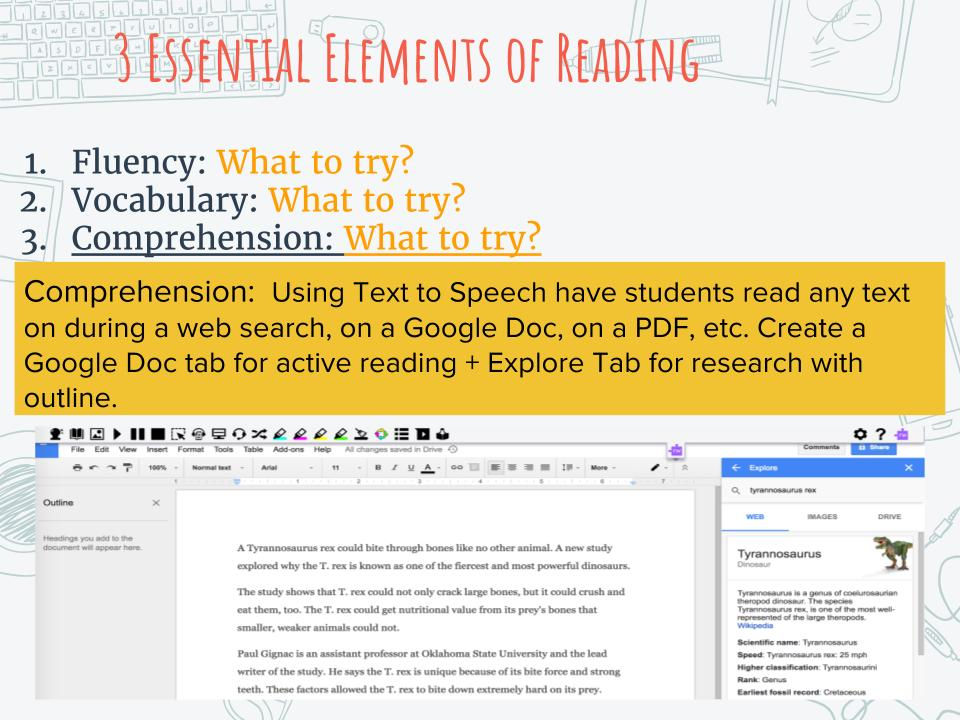Presentation at International Society for Technology in Education (ISTE)
- Tara Mason
- Jun 21, 2017
- 4 min read

I will be heading to ISTE on Sunday for the annual international conference with participant numbers expected to be 30,000+ in San Antonio, TX! Get ready for a toasty climate, great food and San Antonio's southern charm. My presentation will be all about using Google Apps and Extensions in the Chrome browser and iOS accessibility to support literacy. My suggested reading and writing solutions are included in this blog post. See below with some description for each solution suggested.
For Reading: Research around improving reading fluency supports multiple readings and multiple readings where students steadily increase the level of text difficulty. Additionally, using active reading strategies to help students work on both fluency with solid comprehension strategies would be beneficial. Research does not support having students drilling in reading fluency exercises as they go up in grade level, i.e. middle school, would be a great time to have student do multiple readings with increased text difficulty helping build reading confidence, where students start with the lowest level of text complexity, and then gradually increase the challenge and vocabulary.
In the areas of reading vocabulary, using active reading strategies such as highlighting and marking up text making connections can increase vocabulary acquisition for students. Building vocabulary will build stronger readers. From the Council of Students with Learning Disabilities, they suggest:
· Students with learning disabilities often struggle with reading comprehension because they do not possess the oral vocabulary that is a prerequisite to their understanding and retention of content-area texts. Limited vocabulary knowledge can negatively impact the development of a student’s reading comprehension skills.
· There is a strong relationship between vocabulary knowledge and reading comprehension; students need to understand the meaning of critical words they will be reading to promote comprehension. Vocabulary knowledge, along with background knowledge, provides students a better chance of understanding the text they read.
· Students who struggle with reading disabilities most often read less per day than their typically achieving peers, making it more difficult for them to acquire new vocabulary and comprehend academic text.
· Students with learning disabilities may have weak oral language skills which directly impacts their vocabulary development. A limited vocabulary hinders a student’s ability to be successful in comprehending grade level text, participating in classroom discussions, and doing well on assignments, quizzes and tests.These deficiencies often increase over time, making the need for explicit vocabulary instruction even more pressing for students with language deficiencies due to learning disabilities or problems with language acquisition (http://bit.ly/2rSwva6).
Lastly, reading comprehension, do I understand what I am reading? Does it make sense to me and can I connect it to background knowledge or classroom assignments? Newsela has several features that support students comprehending nonfiction news articles. Using Newsela with Google Read and Write's assistive technology features is an excellent way to accommodate and/or differentiate for struggling readers in the area of reading comprehension. A possible lesson plan using these two combined methods: 1. Students chooses article or read assigned article on Newsela, potentially using the differentiated lexile tool to adjust text complexity with multiple readings increasing lexile level each time. 2. Using vocabulary list tool (see Vocabulary slide below) create a list of words student selects as he/she is reading that are unknown. 3. On vocabulary list Google Doc that Read & Write for Google has created, use "Explore" tab to add notes to each new word after reading the definition. 4. Underneath list, have student answer Newsela's quiz questions (See Quick Start Guide for Teachers using Newsela: http://bit.ly/2fd6rMA). Students can complete/submit the quiz on Newsela's site and pick one or more of the questions to cut/paste into their Google Doc to provide a summary of the article for their reading/writing portfolio. 5. Share Google Doc with teacher to collaborate on daily news article reading/comprehension exercise.



For Writing Interventions: the slides below outline possible solutions with QR codes for the areas of writing that could be accommodated or differentiated using Chrome Extensions and Apps.
See blog post regarding 5 Neurodevelopmental Areas of Writing to learn about each area and the challenges students may exhibit.
From the Learning Disability in School site,
"WRITTEN EXPRESSION: MOST COMPLEX OF ALL ACADEMIC TASKS
Written expression is the most complex academic task, but little time is spent on it during classroom instruction (Hooper et al., 2011). One thing that written language requires is what is known as brain boss skills or executive functions." See more of this article: http://bit.ly/2tuqzl0
There is much emphasis on writing and critical thinking in our standards, whether Common Core or state standards linked to CCSS or the like. But we still do a poor job in our educational system teaching writing. I recommend using:
Assistive Technology supports such as Read and Write for Google and Google Apps along with systematic teaching of the writing process. The most well researched and successful writing "program" is a set of strategies, Self-Regulated, Strategy Development Model. I would couple these two supports, i.e. teach students a writing mnemonic from SRSD and prompt them through writing using a Google Form or collaborate using Google Docs.
More about SRSD here: http://www.thinksrsd.com/
More about using Google Apps here: https://www.teachforgoogle.com/course/
More about Read and Write for Google here: http://bit.ly/2srjOC2



























Comments